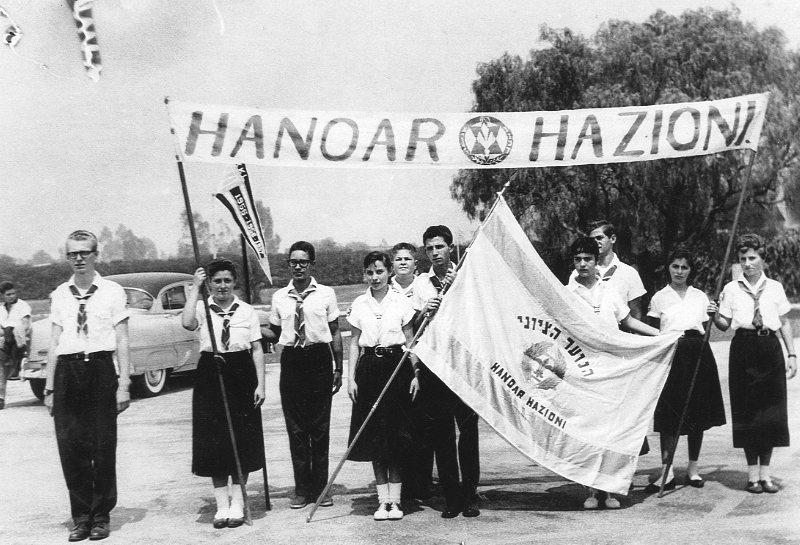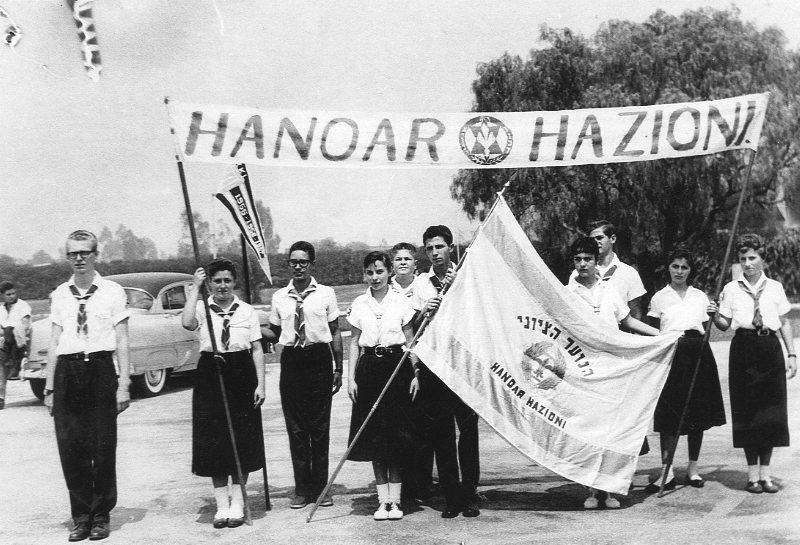

Standing, center, next to the flag - Esther Sklar (later - Derzavich).
Mexico City, Mexico 1958.
(The Oster Visual Documentation Center, Beit Hatfutsot,
courtesy of Ester Derzavich, Israel)
Mexico City
(Place)Mexico City
Ciudad de México
At the onset of the 20th century, the Jewish population of Mexico City numbered in just the hundreds. By 2011, the population had grown to about 40,000 people, making it the third-largest Jewish community in Latin America. In addition to being the country's capital, Mexico City has been the cultural center of Mexican Jewry for generations. As of 2014, nearly 75 percent of Mexico's Jewish population lives in Mexico City.
The origins of Mexico City's Jewish population are quite diverse. Events such as the Inquisition, the fall of the Ottoman Empire, pogroms, and the rise of Nazi Germany brought Jews to Mexico City from a variety of places around the world. There are three main groups which make up the city's Jewish population: Ashkenazi Jews from Central and Eastern Europe, Sephardi Jews from Turkey and the Balkans, and Levantine Jews, primarily from Syria who are themselves divided into two separate communities, the Halebis or Maguen David from the city of Aleppo and the Shamis or Mount Sinai from Damascus. Each of these groups established its own institutions. Despite efforts to unite the different communities, divisions based on places of origin or culture have largely remained, and nearly all religious, educational, and even social, institutions continue to be divided into Ashkenazi and Sephardi.
The Jewish community of Mexico City is very active. There are several organizations which provide the community with a variety of educational and social programs, most of which were founded during the first half of the 20th century. Many of the Jewish social programs were established to assist Jewish immigrants in adapting to life in Mexico. The principal Jewish organization is Comé Central de la Comunidad Judia de Mexico (Mexican Jewish Central Committee). Among other activities, the Committee raises funds for schools and food distribution. An important branch of the Committee is the Tribuna Israelita, a research center founded in 1944 that focuses on media relations, Jewish-cultural projects, and combatting anti-Semitism.
During the mid-20th century, the Ashkenazi Jewish community founded several newspapers and other publications, including the Yiddish publications Mexikaner Idish Lebn, Radikaler Arbeter Tzenter, and Unzer Lebn. El Aleph is a weekly radio show which focuses primarily on Jewish culture.
Another important Jewish institution is the Jewish Community Center (Centro Deportivo Israelita). The largest in the Jewish diaspora, the Center offers a variety of sports and social activities.
Mexico City has many branches of international Zionist youth and social organizations, including Hanoar Hatzioni, Bnei Akiva, Hashomer Hatzair, and Habonim Dror. B'nei B'rith, the Moishe House and ORT also have a presence in Mexico's capital city. Many Jewish students who attend the country's universities belong to the Federation of Jewish Students, or FEMUJ. Between 80 and 90 percent of Jewish children attend one of the city's 12 Jewish schools.
Approximately 95 percent of Jewish families are affiliated with one of 23 congregations in Mexico City. The vast majority of Mexico City's Jews identify as Orthodox or Conservative; liberal streams of Judaism, such as Reform and Reconstructionist, have little to no adherents and no congregations of their own. The oldest remaining synagogue in Mexico still in use is the Sephardi Synagogue located on Justo Sierra Street in downtown Mexico City. Founded by the Syrian-Jewish community and built in 1923, the congregation continues to be a place of worship for those working in the area during the week. Located just down the street from the Sephardi Synagogue is Mexico City's first Ashkenazi congregation. Constructed in 1941, the building is an exact replica of a synagogue in Lithuania. Working from a photograph, its builders were able to capture the Lithuanian synagogue's distinct and ornate details.
The first Jews to reside in Mexico City did so in the city's historic central neighborhood. Known as the Centro Historico, it is the location in the capital where the Spanish laid the foundation for modern Mexico City in the 16th century. Many of the old synagogues in this central neighborhood are still standing.
During the 1930s and '40s, the La Condesa neighborhood had been the heart of the city's Jewish community. This area still boasts the Jewish Museum on Acapulco Street, as well as a number of Orthodox congregations. Between the 1950s and 1970s the vast majority of Jewish families moved west to the areas of Polanco, Interlomas, Tecamachalco, Lomas de Chaupultepec and Bosques de las Lomas. Polanco, a neighborhood known for its wealthy residents, is home to a large Orthodox Jewish community. Other notable Jewish communities can be found in Colonia Hipodromo Condesa, Santa Fe, and Huixquilucan.
In addition to the city's historic synagogues are a number of Jewish landmarks. Of particular importance is the Tuvia Maizel Museum. Inaugurated in 1970, the Museum preserves the history of Mexican Jewry and the Holocaust. In the La Condesa neighborhood is a famous sculpture of Albert Einstein. The monument includes an inscription which reads "A gift from the Israeli community." Another significant site of Jewish interest is the former Palace of the Inquisition on Calle Republica de Brasil in Mexico City's historic downtown. The building had been headquarters for the Inquisition in Mexico, which operated until 1838.